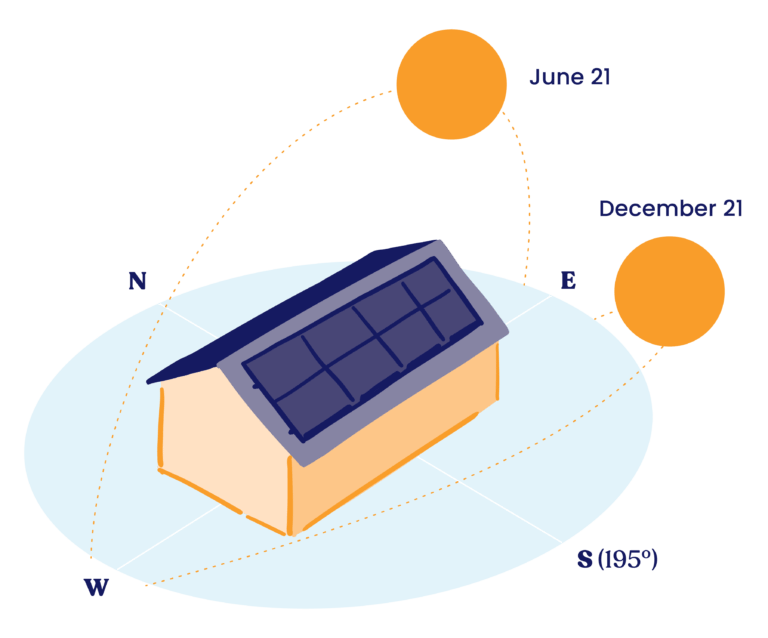ReVision Energy Rooftop Solar Guide
Designed for the solar curious to assess their home's potential for rooftop solar.
You want solar but does solar want you?
If you're considering going solar with ReVision Energy, you probably have a hundred questions floating around your head. How much will it cost? How long will installation take? Will my solar panels still work in the winter (yes, they will)?
However, it is important to first determine whether your house is even a viable solar site, and if solar panels make sense for your home. It is important to figure our some basic information about your house, location, and rooftop before thinking about things like cost and installation--if you don't have a good roof for solar, a site visit from our team may not be worth it and we don't want to waste anyone's time. Luckily, we have a helpful guide to help you assess whether your house is a good solar site.
To determine the viability of your home for solar, you will have to consider:
- Roof design and material
- Roof size and pitch
- Roof age and strength
- The direction your house faces
- Sun and shade exposure
- How much electricity you use
Read on to learn more about these crucial factors, their ideals, and how to assess your own home for them. As you use the guide, we encourage you to take notes and photos, and gather information that will be helpful in answering the questions below.
Is your roof built for solar?
Material, age, and size make a big difference in determining a roof's potential for solar panels.

Firstly, no one has the perfect roof for solar. While some roof shapes and angles are better for solar production than others, solar panels are versatile and can provide energy cost savings and carbon footprint reduction in a wide range of configurations.
That being said, there are several characteristics that effect how much well solar will work on your roof.
1. What material is your roof made of?
What we're looking for: roofs made of strong, long-lasting material--no wood, slate, or corrugated metal.
Solar panels work best with strong, durable roofing materials, such as composite or asphalt shingle, concrete tile or standing seam metal. It’s very difficult (nearly impossible) to install solar on slate and wood roofs because they are so brittle, and we typically avoid corrugated metal roofs because of installer safety concerns.
2. How old is your roof?
What we're looking for: roofs in good, solid condition that won't need to be replaced anytime soon.
Since solar systems last for three decades, if your roof is near the end of its lifetime it’s worth replacing it before installing solar. Solar panels should be installed on roofs that are in good condition and will not need to be replaced in the near future. If you will need a new roof in the next 5 years, we recommend re-roofing first.
3. How big is your roof? What shape is it?
Do you have an open roof that’s free of obstacles like vents, skylights, and chimneys? Or is your roof uniquely-shaped with dormers and other obstructions? Large, wide roofs are best for maximizing your solar system, but even with limited space, you might be able to install a smaller number of high-efficiency panels to produce as much power as possible with the available space.
Along with orientation, the size of your roof will determine how many solar panels you can install. The average US home solar system size is 5 kilowatts or 12-13 panels with a rating of 400 Watts. With solar panels requiring about 15 square feet each, you need about 200 square feet of (south- or west-facing) roof space to fit 13 panels on your roof.
How does your roof interact with the sun?
Unsurprisingly, the way the sun hits your roof is the biggest factor in determining your home's potential for solar.

4. What is the pitch of your roof?
What we're looking for: a roof tilt between 30 and 45 degrees.
The slope of your roof isn’t as important as the orientation, but it can affect your solar energy output. As a general rule of thumb, anywhere between 30 to 45 degrees is the optimal tilt (roof angle) for most solar systems. Luckily, that’s the most commonly built roof in the U.S. Panels that are installed on a steep roof generally produce less electricity and are more difficult to install, and panels on a flat roof might require more seasonal maintenance
There are a few ways to work out the pitch of your roof. You'll need a measuring tape, spirit level and calculator. You'll also need to be able to measure your roof dimensions, either internally in your attic or loft space or externally, with a ladder and some helping hands. Oh, and some knowledge of basic geometry.
The formula you want to use is: Roof Pitch = (1 ÷ Tangent (Rise ÷ Run))*180/π
- First, you need to measure the run of your roof. This is the horizontal length that spans between the peak of your roof and the wall. You can do this with a tape measure or spirit level.
- Next, you need to figure out the rise. This is the height of your apex above the structure wall.
- Now, divide the rise by the run. This will give you the tangent of the roof. (rise ÷ run = tangent)
- Then, divide 1 by your tangent.
- Finally, multiply this result by 180/π and you've calculated your roof pitch!
Example: Rise of 8m, Run of 5m.
- 8 ÷ 5 = 1.6
- 1 ÷ 1.6 = 0.625
- 0.625 x 180/π = 35.80986...
- Therefore, the roof pitch is 35.81°!
5. What direction does your roof face?
What we're looking for: a roof facing south.
Any roof facing between Southeast and Southwest is great for solar. The perfect solar orientation in New England is 195 degrees (15 degrees West of due magnetic South on a compass, also known as ‘true south’) but any orientation between 150 and 240 degrees is within 10% of perfect.
Not having a south-facing roof is not a deal-breaker. However, many roofs are multi-faceted, and if your roof is mostly west- and east-facing, you might see a slight reduction in the amount of energy you’re generating. Ultimately, south is best, but west and east are also good. As long as you have a significant number of panels facing south and west you will generate energy throughout the day
Using a compass or a compass app on your phone, stand in front of the side of your house where the largest section of your roof faces outward, and hold the compass flat in front of you. Mark the direction facing straight ahead of you and write it down. Do the same thing on all sides of your house with a large section of your roof.
6. How much sun does your roof receive?
What we're looking for: a roof that receives full sun between 9am-3pm every day.
No matter how ideal your roof might be, if it is shaded by other buildings or trees for most of the day it will no provide an ideal location for solar panels.
Ideally, we like to see a shade-free solar ‘window’ between 9am-3pm, year-round. When evaluating your site, a solar professional will use a tool such as a SunEye or Solar Pathfinder. These tools take a fish-eye photo of the open sky, taking trees and other obstacles into account, and then super-impose the sun’s arc (adjusted for longitude) onto the open sky photo. The results can be interpreted by software to develop a percentage figure of available solar access at a site; generally greater than 80% is required but we prefer to see access that is 90% or more.
Shading doesn’t always come from trees and outside objects — sometimes roofs can shade themselves. The best roof design for solar panels is one with minimal tiers and overhangs that could cause shading. We recommend tracking the sun on your roof for a couple days and noting how much sun or shade is on your roof during peak hours.
If you're shaded for most of the day by trees, you can look into getting them removed, which could expose your roof to more sun and make it a more viable solar site.
How much solar will you need?
Can your roof fit a solar array that will fit your needs?
This is the easy part. The size of your potential solar array will be dependent on your current energy usage. We have a handy Solar Calculator that can estimate the solar system size you will need to offset your current usage based on a recent electric bill and your location.
Though it's still only an estimate, our Solar Calculator calculates the number panels you'll need and the associated costs. We use the following to create your custom estimate:
- Your monthly electric bill. Our tool takes your monthly electric bill in dollars, and divides it by the current average price for electricity, to get the number of kilowatt-hours of electricity you need each month.
- The production of a solar panel. In our region, 1 kilowatt of a solar panel array will produce roughly 1,200 kilowatt-hours of electricity each year. The average size of a solar panel in 2023 is 400 watts. If you have a $150/month electric bill and live in Southern Maine, where the average rate for electricity is $0.21 per kilowatt-hour. 150/0.21 = 714 * 12 = 8,568 kilowatt-hours needed each year. 8,568 kWh / 1,200kWh/yr = 7.14kw solar array.
- Technical sizing of a solar array. To translate the example above of 7.14kw of solar into an installable solar array, our tool does some rounding based on actual solar systems. We use pricing pulled from average system sizes installed over the last year. Your actual results may vary. For example, if your roof is not ideally oriented, or you have trees in the yard, that will reduce a solar panel’s performance. Using our experience and past years’ install data, we know that a 7.14kw solar array will be made up of roughly 20 solar panels.
- Your location. Our calculator is designed to give you customized results based on the specific electricity rates in your state. Incorporating data from past installation projects done in Maine, New Hampshire, and Massachusetts, we are able to calculate a more accurate number using state specific rates

